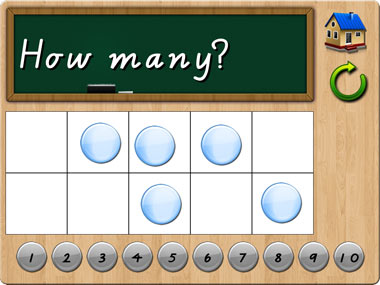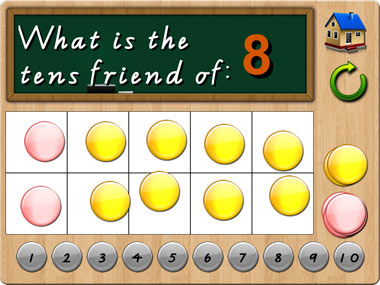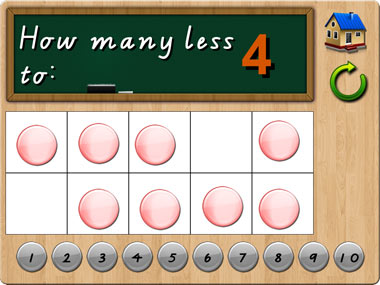Friends of Ten
Little Monkey Apps Friends of Ten is an activity to be used in the early years of schooling to introduce an early understanding of numbers to ten, counting objects to ten, subitising - recognising a collection of objects without counting them, counting on from a higher number, partitioning of objects and the combinations that make ten 8+2, 2+8, 1+9, 3+7 etc. These skills underpin mental addition and subtraction.
The importance of recalling number combinations that make ten are that students use strategies for addition, that is, knowing that 7+3 is the same as 8+2. This introduces the idea of patterns and compensation (one up, one down). These activities develop the concept that addition and subtraction are linked.
Little Monkey Apps Friends of Ten can be used in the traditional classroom to collaborate with a small group or used by individual learners. For both types of users, a written record such as poster or chart collating knowledge of what was said previously allows revisiting and adding to knowledge.
Little Monkey Apps Friends of Ten is designed to encourage verbal communication about discoveries and build upon previous knowledge. Little Monkey Apps Friends of Ten tasks are often best utilised through the Threading technique. That is the task is to be used 2 or 3 times a week for a few minutes each time over a period of time. The student(s) are therefore familiar with the structure of the activity but the challenge is new each time. This technique allows students to construct their own learning.

The App is broken up into a number of sections. A teaching module and independent tasks to reinforce skills.
- Tens Frame - Teaching module - a blank form with counters to be used with teacher interaction
- Show me - Independent or collaborative task to create a given number on the Tens frame
- How many - Independent or collaborative count, recognise and move counters to make it easier to count.
- Friends of Ten - Independent or collaborative
- How many less? Independent or collaborative
- How many more? Independent or collaborative
Recognising and Making Numbers

Initially students will demonstrate an understanding of numbers to ten by arranging counters or objects a 'Tens frame.' Use the Tens frame section to do this. Some students will commence counting from 0 when they place the counters on the frame. Some may arrange the counters haphazardly whilst others will arrange the counters on the top row or in 'partners'. Be led by the child's answers and look for 'teachable moments'.
Teachers should ask:
- Can you show me five?
- Is there another way you can make that?
- How can we arrange the counters to make it easier to count?
- Is that number odd or even? Does each counter have a partner or is one the odd one out?
- Why was that number easy to make?
Show me and How many are tasks that can be completed independently to support counting and subitising (automatic recognition how many dots there are).
Friends of Ten
Use the 'Tens frame' to direct, students to create patterns or Friends of Ten. Ask them to make 8, how many spaces left? Students will come to recognise the ten friends such as 8+2, therefore 2+8, 1+9, 3+7 etc. This skill underpins mental addition and subtraction. Use different coloured counters to make these combinations.

Teachers should ask:
- Can you fill the tens frame with TWO colours of counters?
- Can you make a pattern with two colours?
- How many blue / How many red?
- Can you make a number? What is that number
- There are spaces, do you know how many spaces left?
- Can you fill them with counters counters?
- How many altogether?
- Can you make five blue and five green? Is there another way to arrange that to make it easier?
- How did you do that so quickly?
Friends of Ten is a task that supports this teaching moment.
Addition and Subtraction Facts to ten

Once students have mastered using the Tens frame, moving counters to make them easier to count, How many less and How many more are tasks that ask students to add or subtract counters. It is important that students physically move the counters to help them process what is being asked. Skills learnt in these section are counting on 5+3 = 5... 6, 7, 8, rather than starting from 0 or counting back 8-2= 8... 7,6 and partitioning 5+5 can be broken up into two rows.
- Updated:
- Version:
- 1.06
- iOS:
- Compatible with iPhone, iPod touch, and iPad.Requires iOS 4.0 or later.
- Size:
- 7.0 MB
- Price:
- $.99